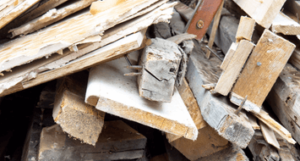HOW NOT TO WASTE YOUR WASTE WOOD
Wood is known to be one of the most naturally renewable materials. But with the Wood Recyclers Association (WRA) estimating that the total amount of waste wood collected in the UK 2020 was 4,500,000 tonnes, how can we ensure that all of this doesn’t go to waste?
GRADING YOUR WASTE WOOD
 The WRA provides guidance on the grading and uses of waste wood, ranging from A – D. This information explains what you can and should do with different types of wood, which we’ve broken down for you:
The WRA provides guidance on the grading and uses of waste wood, ranging from A – D. This information explains what you can and should do with different types of wood, which we’ve broken down for you:
Please note: The below guidance is meant for those involved in the UK waste wood recycling sector. Different regulations and guidance may apply for companies using on-site generated waste wood to produce heat.
Pre-Consumer Waste Wood and Untreated Wooden Packaging (Clean/Untreated) – Grade A
If your material is clean/untreated, it shouldn’t contain any treated or low-grade material. This material comes from Wood Product Manufacturing, Retail, Packaging, joinery and pallet reclamation.
As this is the highest classification, it can be repurposed for animal bedding, panel board feedstock, landscaping or equestrian surfaces, biomass pellets and briquettes. It can also be used as fuel in biomass installations, including those used for the Renewable Heat Incentive (RHI) Scheme.
Business Waste Wood (Treated Non-hazardous) – Grade B
Grade B waste wood often comes from the same sources as Grade A, but can also come from construction and demolition operations, skip operators and waste transfer stations.
Grade B is mostly solid wood and is classified as treated, but non-hazardous. This wood is the preferred feedstock for industrial wood processing operations such as the manufacture of panel board products, but we can also use it as an alternative fuel to produce energy.
Municipal Waste Wood (Treated Non-hazardous) – Grade C
Grade C waste wood is mostly board products, such as flat-pack furniture and DIY materials. It often originates from the same sources as Grades A and B, but it can also be found in municipal collections and Household Waste Recycling Centres (HWRCs).
This wood is mainly suitable as an alternative fuel source in biomass installations, generating green electricity. It can also be used for panel board manufacture with correct processing and blending.
Hazardous Waste Wood (Treated Hazardous) – Grade D
Grade D waste wood is declared hazardous. Therefore, it must be segregated and disposed of correctly at sites permitted to accept hazardous wood.
This wood typically contains copper chrome arsenic preservation treatments and creosote. It is normally found in docks, boats, carriages or industrial applications.
Next steps
Knowing the grading of your wood is only step one in ensuring your material ends up in the right place.
By undertaking analysis from a reliable and trusted laboratory, you can gather accurate information relating to your material and ensure you comply with your environmental commitments.
How can you ensure you grade your wood correctly? How can AHK help?
Are you unsure on what grade your waste wood falls under, but want to make sure it is repurposed, recycled or disposed of correctly?
AHK has worked with numerous organisations to help them understand the quality of waste material and its further uses. We can provide standard/bespoke suites of analysis to help you understand the quality of your material and its further uses.
If you’d like to speak to a member of the AHK team, get in touch today.